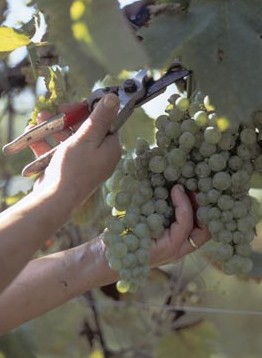I started writing this piece in December last year, and have only just come back to it, at the end of April 2014. “Writer’s Block” is my excuse; even Shakespeare may have suffered from it. I am self-medicating with a glass of Prosecco as I write.
The Prosecco in question is simple, direct and inexpensive, tasting of white pear, slightly sweet and tinged with green apple; lightly sparkling; and it’s working for me. No ceremony needed. Little wonder Prosecco is (according to anecdotal evidence) the fastest growing segment of the sparkling wine market world-wide. It enjoys sitting well under the price umbrella and cachet of Champagne.

Prosecco Grapes
This example is from Canella, it’s non-vintage and under Italy’s wine labelling system it has, of course, an absurdly complicated name: “Prosecco di Conegliano-Valdobbiadene Denominazione di Origine Controllata et Garantita“. The “Garantita” bit was added in 2009, so it’s old news however the addition pricked my interest. But I’m tipping most punters are still just asking for a glass of Prosecco thanks (much as they might ask for a glass of “Sav Blong” or “Savvy” in the upper classes).
So what prompted the promotion from “DOC” to “DOCG”? Most likely the enormous lift in sales of Prosecco worldwide from around 2004/5, following which other countries than Italy filled the void in supply by providing “Prosecco” in all sorts of formats including ring top cans. The Italian wine industry responded by elevating the best (hillside) vineyard areas to DOCG and cleaned up the rest of the region by designating the surrounding area DOC (that’s “controlled” but not “guaranteed”) imposing standards for production. There was a fair amount of very ordinary Prosecco produced in Italy.
I’m all in favour of protecting legitimate geographical indicators of origin and Australia signed up to an agreement with the European Union in 1994 which does exactly that. We no longer use European terms like “Champagne”, “Sherry” or “Port”, etc. Don’t get me started on “Muscat” and “Tokay” but by and large it’s all very sensible.
The Wine Australia Act contains the framework for this protection by establishing the Australian Register of Protected Geographical Indications. Under the Act, the EU can apply for listing of Geographical Indicators recognised in the EU on the Australian Register.
However, to obtain that registration, the GI must be a genuine geographical name and sensibly, the legislation in Australia says the name of a grape variety, such as Prosecco is not a geographical indicator. Much the same rules apply in Italy and for the EU.
The Italian way to deal with this was commendably simple. Let’s change the name of the grape variety to “Glera” (apparently an old synonym for Prosecco) and we don’t have the problem. This was all done with the stroke of an administrative pen in 2009.
Following this act of legerdemain, the EU made application for the inclusion of “Prosecco” on the Australian Register. The local implication would have been that many Australian wines made from that variety would have to find another name. “I’ll have a glass of Glera thanks” doesn’t exactly slip off the tongue. The “G” in Glera requires an epiglottal delivery; besides, we’ve become used to asking for a glass of “Prosecco”.
In a very sensible decision the application was refused, on the basis that in Australia “Prosecco” is the name of a grape variety grown here since the middle 1990s and made into wine and labelled as such since at least as early as 2004.
Now I do have some sympathy with the Italian Prosecco producers. Some authorities say that the grape takes its name from the town of Prosecco near Trieste; the wine was known as “Prosecho” at some time in the far distant past. Further, I haven’t seen any still wines produced from the variety and I reckon the commercial use of the term is entirely on the back of the reputation for the sparkling style established in Italy, rather than variety. Be that as it may, I think it’s the right result. Australian producers of wine made from the Prosecco grape variety can continue to label it by the varietal name, in Australia. What they can’t do is export it to the EU labelled as Prosecco.
After all of that, I’m tempted to think of Juliet, sitting on her balcony in Verona (not that far from Conegliano- Valdobbiadene), glass of Prosecho in hand, pleading with Romeo, fumbling around after dark in the Capulet family orchard (and with apologies to the great bard):
“What’s in a name? that which we call Prosecho
by any other name would taste the same.”
|
|
Tweet |


No comments to Prosecco – What’s in a name? | Comments Feed
No comments yet
The comments are closed.